Understanding Competitor Analysis
Definition and Importance
Competitor analysis, also known as competitive analysis or competition analysis, is a fundamental process for businesses aiming to enhance their market presence and strategic planning. It involves examining similar brands within an industry to gather insightful data regarding their offerings, branding, sales approaches, and marketing strategies. This analysis serves as a crucial tool that allows companies to identify their competitors’ strengths and weaknesses, thereby equipping them to create a competitive edge in their respective markets. Through a thorough competitor analysis, businesses can refine their strategies and even anticipate market trends that may affect their operations.
Key Objectives of Conducting Analysis
The goals of conducting a competitor analysis are manifold. Primarily, it helps organizations to:
- Understand Market Position: By analyzing competitors, businesses can assess their own position in the market and identify opportunities for improvement.
- Benchmark Performance: Comparing key performance indicators (KPIs) with competitors allows an organization to set practical performance benchmarks.
- Identify Customer Needs: Competitor analysis can reveal customer preferences and gaps in the market, which can inform product development and marketing strategies.
- Enhance Marketing Strategies: Gleaning insights from competitors’ marketing efforts can inspire new marketing tactics and campaigns tailored to target demographics effectively.
Types of Competitor Analysis
There are several types of competitor analyses that businesses can conduct, including:
- Direct Competitor Analysis: This focuses on businesses that offer the same products or services within the same market.
- Indirect Competitor Analysis: Involves assessing those who offer substitute products that may fulfill the same customer needs.
- Market Position Analysis: Examines how competitors position themselves within the market, their branding strategies, and target audience.
- SWOT Analysis: This encompasses strengths, weaknesses, opportunities, and threats of competitors, providing a holistic view of the competitive landscape.
Steps to Conduct Effective Competitor Analysis
Identifying Your Competitors
The first step in effective competitor analysis is identifying both direct and indirect competitors. This can be achieved through various methods:
- Conducting online research via search engines or social media.
- Utilizing business directories and industry reports to uncover competitors.
- Engaging in customer surveys to discover alternative brands that consumers are considering.
- Examining competitor reviews and feedback on platforms such as Yelp or Google Reviews.
Gathering Data on Competitors
Once competitors are identified, the next step is to gather comprehensive data about them. This data can include:
- Product Offerings: Identify the range of products offered, their features, pricing, and any unique selling propositions (USPs).
- Marketing Strategies: Analyze competitors’ marketing channels, campaigns, and the messaging they employ.
- Website and SEO Performance: Evaluate their online presence, website traffic, and search engine optimization strategies.
- Customer Feedback: Review customer testimonials and feedback to measure satisfaction and pain points associated with their offerings.
Analyzing Competitor Strengths and Weaknesses
An essential part of competitor analysis is evaluating the strengths and weaknesses of your competitors. This involves:
- Conducting SWOT analysis for each competitor.
- Identifying unique strengths such as superior technology, brand loyalty, or operational efficiency.
- Highlighting weaknesses such as gaps in customer service, inadequate product features, or negative brand perceptions.
- Assessing overall market share and positioning within the industry.
Tools and Resources for Competitor Analysis
Popular Competitor Analysis Software
Several tools can facilitate effective competitor analysis. These include:
- SEMrush: A comprehensive SEO and marketing tool that allows users to analyze competitors’ online performance and strategy.
- SimilarWeb: Ideal for understanding web traffic and site engagement metrics of competitors.
- Ahrefs: Useful for detailed backlink and SEO analysis to gauge how competitors rank in search engines.
- BuzzSumo: This tool helps analyze competitors’ content marketing strategies and identifies popular content within your industry.
Utilizing Online Resources Effectively
Besides software, various online resources provide valuable insights for competitor analysis, including:
- Industry reports and whitepapers that can provide overarching market insights.
- Social media analytics to monitor competitors’ engagement and audience interaction levels.
- Forums and community discussions that can shed light on consumer perceptions of competitors.
Leveraging Social Media Insights
Social media platforms are treasure troves of information regarding competitor strategies. To leverage these insights, businesses should:
- Track competitor posts for the type of content that generates the most engagement.
- Analyze customer comments and interactions to gauge public perception.
- Monitor social advertising campaigns for creative insights and performance metrics.
Implementing Insights from Competitor Analysis
Developing Strategic Visions
The insights gleaned from competitor analysis can significantly influence strategic business decisions. Businesses can:
- Refine product development strategies based on competitors’ offerings.
- Adjust marketing messaging to resonate better with target audiences.
- Identify potential partnerships or collaborations that can leverage market opportunities.
Benchmarking Performance Indicators
Using data from competitor analysis, organizations can set relevant performance benchmarks to measure their success against the competition. This involves:
- Defining key performance indicators (KPIs) relevant to the industry.
- Setting achievable targets based on insights from competitors.
- Regularly reviewing these benchmarks to continuously improve performance.
Adapting Marketing Tactics
Based on in-depth competitor insights, businesses can adapt and refine their marketing tactics to better align with market dynamics:
- Implement tactical shifts in online advertising and content marketing strategies for better outreach.
- Experiment with promotional offers that competitors use successfully to attract customers.
- Use A/B testing to identify which adaptations resonate most with the target audience.
Common Mistakes and Challenges in Competitor Analysis
Overlooking Indirect Competitors
A common pitfall is failing to account for indirect competitors. These businesses may offer substitute products that could capture a segment of your customer base. To avoid this, organizations should broaden their competitive landscape to include these alternatives in analysis.
Relying on Incomplete Data
Analysts often make the mistake of drawing conclusions based on insufficient data. Companies should ensure they have access to comprehensive data sets and combine quantitative with qualitative insights for a well-rounded overview of competitor strengths and weaknesses.
Ignoring the Continuous Nature of Analysis
Markets are dynamic, and competitors can change their strategies rapidly. Organizations should treat competitor analysis as an ongoing process, regularly updating their findings and strategies accordingly to remain competitive in their market.


